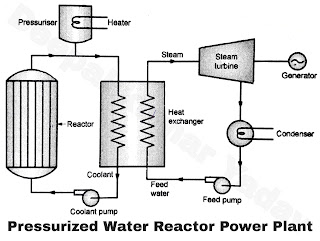The Pressurized Water Reactor (PWR) Power Plant and its Advantages and Disadvantages
- The schematic diagram of PWR power plant is shown in Figure. It uses enriched uranium.
- The water or heavy water (usually) under pressure is used both as coolant and moderator. Before starting the reactor the water in pressuriser is boiled and converted into steam by electric heating coil.
- In order to prevent the boiling of water in the core, it is kept under pressure of about 130 to 150 bar. It helps in absorbing the heat by water in the liquid state in the reactor.
- The heat energy absorbed by water in the reactor is used for converting the water into steam in a heat exchanger. This stem is used in a conventional way in the steam power plant cycle as shown in Figure.
- The water coolant from heat exchanger is re-circulated to the reactor with the help of coolant pump. These power plants are compact and its cost is reduced since it uses water both as coolant and moderator.
- However, the high pressure in the primary circuit of water absorbing heat in the reactor requires a strong reactor shell which increases its cost. In this reactors, the water flowing through the reactor becomes radioactive, therefore this primary circuit must be heavily shielded to protect the operators.
- Water is used both as coolant and moderator which is cheap and easily available.
- Reactor is compact.
- Small number of control rods are required.
- Fission products remain contained in the reactor.
Disadvantages of Pressurized Water Reactor (PWR) :
- Capital cost is high since the reactor and primary circuit works under pressure.
- Only saturated steam can be generated in secondary circuit, therefore the efficiency of plant is low.
- Costly shielding-is required to shield the operators in primary circuit since the coolant becomes radioactive.
- Severe corrosion problems.
- Fuel suffers from radiations. Therefore, its reprocessing is difficult.
- Plants needs to be shut down for fuel charging.
